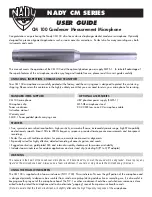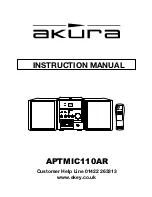
english
21
2. Connect the supplied microphone or instrument cable to the jack socket (4).
3. Switch on the beltpack transmitter by switching the On / Off switch (6) to the “On” position.
The power on battery condition LED (5) is illuminated green when the battery has been
inserted correctly and has full capacity. If the transmitter is properly working, one of the
diversity LEDs of the NE 100 receiver should be illuminated.
4. Make sure that the mute switch (1) is switched to the “Off” position. The mute switch (1)
is for muting the transmitter during pauses of speech. Please note that the microphone is
still consuming power when it is muted.
5. When the battery capacity is too low for operation, the power on battery condition LED (5)
will flash for around 1 hour before the transmitter switches off (LED (5) goes out).
3.3
Adjusting Input Gain
1. Switch on the NE 100 diversity receiver.
2. Switch the transmitter on by switching the On / Off switch (6) to the “On” position. Turn
the gain control (3) to minimum sensitivity (fully counter clockwise).
3. If you have no suitable sound source, you can speak into the microphone at the maximum
level you expect to use. We recommend you choose a “U”, because a spoken “U” has a
relatively good sine-shape. Turn the gain control (3) clockwise until the peak LED (2) does
not illuminate or should only flash momentarily during the loudest passages.
Important:
There are various microphones available for the TS 100. As their characteristics vary, the sensitivity
has to be re-adjusted with each change of microphone.
4.
General Instructions for all Transmitters
4.1
Battery Change
•
Switch the transmitter off before changing the battery (On / Off switch to the “Off” position).
•
If you do not intend to use the transmitter for several weeks or months, please remove the
battery as it can leak after some time and damage parts of the transmitter. Even “leak
proof” batteries are no guarantee that they will not leak after some time. Failing to
comply will render the warranty null and void.
•
Different brands of batteries may vary in length of up to 2 - 3 mm. When you change the
battery make sure there is a good contact and adjust the spring in the battery compartment
if necessary.
•
Clean the battery contacts from time to time. Use a soft cloth or cotton swab moistened
with methylated spirits or alcohol.
•
Please do not throw used battery packs away with your household rubbish, but take them
to your local collection points.
•
When using rechargeable batteries use conventional chargers.
Heruntergeladen von
Handbücher-Suchmachiene
















































